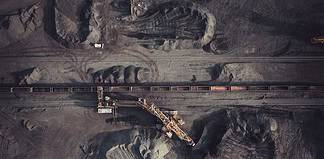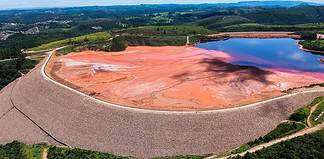AFTER uncertainty in the sector in recent years, Tasmania’s mining industry is seeing something of a renaissance with new mines opening, an aggressive Mining for the Future policy that would make illegal protesting an indictable offence, and greenfields exploration seeking out the next big find.
The industry has the backing of the Hodgman Liberal Government, which is promising to provide stability and certainty, and to assist miners moving forward.
Mr Barnett said that the Liberal Government was determined that there would be no more land-lockups, likening the current movement to the anti-forestry movement.
“More than half of Tasmania is already in reserves,” he said.
“And yet the Greens call for more.”
The resources industry employs about 5600 people in Tasmania, many of them from regional areas, and exported about $2.1b in FY19, making up more than half of Tasmania’s exports.
Mr Barnett said that mining contributes about $35m to the treasury each through royalties.
“And the flow on effects are significant,” he said.
“Rail and port services are utilised by the industry to transport the products.
“The need for stable and affordable energy provides the manufacturers with a significant advantage over the mainland states, and with the added benefit of our green renewable hydro and wind energy resources the attraction of our State for manufacturing and mineral processing is becoming more and more relevant.
“The industry helps to strengthen regional Tasmanian communities with valuable employment opportunities and skills and training programs, as well as hundreds of small businesses which benefit from the broader supply chain.”
The Green challenge and greenfields
On October 16, the Tasmanian Greens called for a prohibition on new thermal coal mines in Tasmania.
MP for Franklin, Rosalie Woodruff, said that the government’s announcement of a $50,000 enticement toward Midlands Energy had brought together a “breathtaking collaboration” of opposition to coal mining in the state.
“It has tapped into a depth of concern about what is happening in the global climate, a recognition of the urgent need for action and a real eye-watering sort of outrage, I suppose, at the ludicrous prospect of handing out thermal coalmining leases in this time, in this place,” she said.
“None of us in this room can say that we no longer understand that emissions from mining and burning thermal coal will add to the already dangerous level of global heating that is occurring.”
But the Liberal Government has pulled no punches when it comes to Green intervention in mining.
In its mining for the future policy, it states that “the Liberals believe that the best way to stop unlawful market attacks by Green groups is not to appease them; it’s to toughen the law to deter them”.
The policy aims to make protesting in a way that impedes access to a workplace an indictable offence with on-the-spot fines of up to $10,000 for individuals, and up to $100,000 for corporations that incite or encourage illegal behaviour.
Mr Barnett echoed this sentiment, calling the Greens’ demands a stunt.
“It was the Greens again ignoring the facts, scaremongering and wanting to ban any of our job creating industries, first forestry now mining,” he said.
“Coal mining is an important industry in Tasmania, and currently supports the production and export of over one million tonnes of cement by Cement Australia from its Railton cement manufacturing site.
“Coal has been continuously mined in Tasmania’s Fingal Valley since 1886.”
And on supporting new greenfield development, the government appears to be putting its money where its mouth is.
The Mining for the Future policy has put forth three initiatives that support the industry, and exploration in the state.
Firstly, it is pouring $1.4m over four years into a geoscience program that would provide new data and ideas to underpin and de-risk the next generation of mineral exploration activities.
Secondly, the Mining Sector Innovation Initiative will invest $1m over four years to address environmental, geoscience and natural hazard issues.
Thirdly, the Exploration Drilling Grant Initiative (EDGI) will invest $2m over four years, which is aimed at encouraging drilling of greenfields targets that could lead to new discoveries. To date, 21 successful applicants have been awarded grants.
If the designated projects are completed as planned, the grants totalling $960,000 will have contributed to 10.5km of drilling, and the total exploration investment would be about $2.9m with co-funding, assaying, mobilisation and de-mobilisation, and site rehab.
Tin and new projects
Tin mining has been a stalwart of the Tasmanian economy since the discovery of Mt Bischoff in 1871 by James Philosopher Smith.
There are a number of tin projects ready to go: Venture Minerals’ has called its Mt Lindsay project one of the biggest undeveloped tin deposits in the world, with a current JORC resource of 13mt at 0.7pc Sn equivalent, while also identifying a tungsten mineralisation.
Stellar Resources’ Heemskirk tin project is a high-grade resource across three deposits around Zeehan near Tasmania’s west coast.
The combined mineral resource is estimated at 6.35mt at 1.13pc Sn, and a further open-pittable deposit is located nearby at St Dizer.
My Barnett said that although tin had been consistently declining since the beginning of the year, at $24,000/t the price was robust.
“Tasmania has some of the world’s best unexplored tin resources,” he said.
“Tin remains an important commodity for the development of electronics, including electric cars, and technology going into the future.
“I see a great deal of investment upside and potential in Tasmania for the discovery and utilisation of our abundant tin resources.”
Aside from tin, there are other new mines coming on board in Tasmania, including the re-start of the Mt Lyell copper mine, the commencement of operations at the Rogetta iron ore mine, Venture Minerals starting production at the Riley iron ore mine, and Dundas Mining’s announcement of its intention to resume mining at the Avebury nickel mine.
The Bluestone Mines Joint Venture is moving towards a major investment in the recovery of tin and copper tailings at the Renison tin mine via the Rentails project.
The company intends to recover minerals from tailings storages that have accumulated over more than 100 years.
And Grange Resources has recently announced a 45pc increase in resources, and are developing an exploration decline at its Savage River magnetite mine as part of a feasibility study into taking mining underground.
Hellyer
In January, NQ Minerals commissioned its processing plant at its flagship Hellyer gold mine.
In May, the company reached the milestone of the first bulk shipment of precious metal pyrite concentrate which had a higher than forecast grade for both gold and silver.
Throughout 2019, the mine has consistently improved on production with Q3 increasing metallurgical recoveries from 36.5pc to 45.35pc in the lead circuit, and from 33.7pc to 42pc in the zinc circuit, these recoveries comparing with life of mine projections of 47pc for lead and 38pc for zinc.
Mr Barnett said that the company was doing a fantastic job of extracting minerals from the tailings facility at the Hellyer site.
“This project demonstrates the level of returns that can be generated from waste products, and also provides a valuable environmental benefit with the removal of potentially acid-forming materials from the local environment,” he said.
“We wish the company all the best in their ongoing endeavours at Hellyer, and look forward to other such opportunities being taken up in the future.”








































